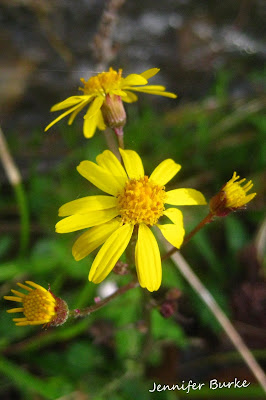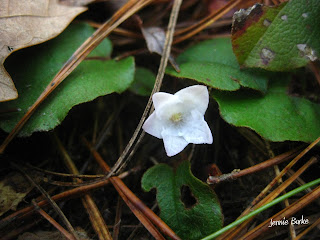Today I hiked with some friends on Grapeyard Ridge Trail, which is 7.6 miles long. We started in the Greenbrier area of Great Smoky Mountains National Park and hiked over to a car we had parked on Roaring Fork Motor Nature Trail. This trail took us through a variety of habitat types which yielded a wide array of wildflower and bird species!

 Here is a strange looking plant that took us a while to figure out. After seeing it several times, we finally decided that this structure must be the early flower buds of Galax, Galax urceolata, which generally doesn't bloom until May or June. This plant grows in dry, acidic soils, often along side Trailing Abutus, Epigaea repens, Mountain Laurel, Kalmia latifolia, and other members of the Heath family. It's also noteworthy to mention that Galax has a distinctively pungent odor.
Here is a strange looking plant that took us a while to figure out. After seeing it several times, we finally decided that this structure must be the early flower buds of Galax, Galax urceolata, which generally doesn't bloom until May or June. This plant grows in dry, acidic soils, often along side Trailing Abutus, Epigaea repens, Mountain Laurel, Kalmia latifolia, and other members of the Heath family. It's also noteworthy to mention that Galax has a distinctively pungent odor.
Wild Oats, Uvularia sessilifolia, is a member of the Lily family that is usually found in dry soils.
I haven't seen this flower since last year, and even then I think I only saw it once. There were several beautiful patches of Wild Oats on Grapeyard Ridge
Here is another wildflower that we found somewhat challenging. After consulting a field guide, we deduced that this aster is likely Golden Ragwort, Senecio aureus. It was growing alongside the creeks that we frequently crossed during the first 2 miles of this trail.
Bloodroot, Sanguinaria canadensis, is one of the earliest blooming wildflowers in our area, so I was somewhat surprised to see a few still in bloom.
Trout Lily, Erythronium umbillicatum, is a beautiful and interesting wildflower. I always see more trout lily leaves than flowers. Last year I learned that trout lilies only produce flowers when they have two leaves. Therefore before they even bloom you can predict which plants will produce flowers and which will not.
Spring Beauty, Claytonia virginica, is another early spring wildflower that has been in bloom for a while now.
There are 11 species of Phlox in Great Smoky Mountains National Park. Luckily they don't all bloom at the same time and in the same place. This is likely Creeping Phlox, Phlox stolonifera.
Rue Anemone, Thalictrum thalictroides, is everywhere right now!
Rue Anemone, Thalictrum thalictroides
Blue Cohosh, Caulophyllum thalictroides, is named after its blue stem and blue flower buds.
It was just beginning to come into bloom, and as you can see the flowers are yellow and not blue as you might expect!
Dutchman's Breeches, Dicentra cucullaria.
I was excited to see this member of the lily family, Large-flowered Bellwort, Uvularia grandiflora. We only encountered this single flower in bloom on our hike.
Wild Geranium, Geranium maculatum, being pollinated by a bee!

Wood Betony, or Lousewort, Pedicularis Canadensis.
The last mile of Grapeyard Ridge and Roaring Fork Motor Nature Trail were covered with this beautiful trillium in shades of white and pink! These flowers turn pink with age.
We saw over 30 different species of wildflowers today! In addition to those pictured above, we also saw:
Plantain-leaf Pussy Toes, Antennaria plantaginifolia
Trailing Abutus, Epigaea repens
Cut-leaf Toothwort, Dentaria lacinata
Wild Ginger, Asarum canadense
Wood Anemone, Anemone quinquefolia
Buttercup, Ranunculus sp.
Star Chickweed, Stellaria pubera
Halberd-leaf Violet, Viola hastate
Wood Violet, Viola palmate
Yellow Woodland Violet, Viola pubescens
Round-leaf Yellow Violet, Viola rotundifolia
Long-spurred Violet, Viola rostrata
Common Blue Violet, Viola sororia
White Violet, Viola sp.
Yellow Trillium, Trillium luteum
White Erect Trillium, Trillium erectum
Bishop's Cap, Mitella diphylla
Serviceberry, Amelanchier sp.
We also saw and heard lots of birds!
This black and white warbler was one of the few birds I actually saw. I rely heavily on identifying birds by their songs rather than sight, as these tiny songbirds can be extremely difficult to locate visually.
Birds I heard include:
Broad-winged Hawk
Wild Turkey
Downy Woodpecker
Pileated Woodpecker
Blue Jay
Northern Parula
Louisiana Waterthrush
Black-throated Green Warbler
Ovenbird
Hooded Warbler
Black and White Warbler
Carolina Wren
Tufted Titmouse
Carolina Chickadee
Blue-headed Vireo
Dark-eyed Junco
Eastern Towhee
Pine Sisken















































